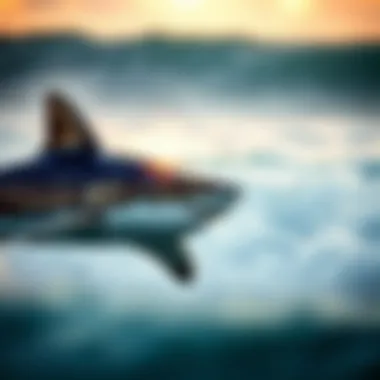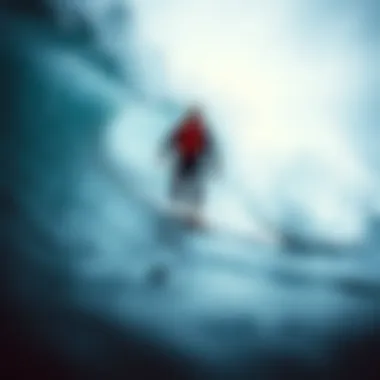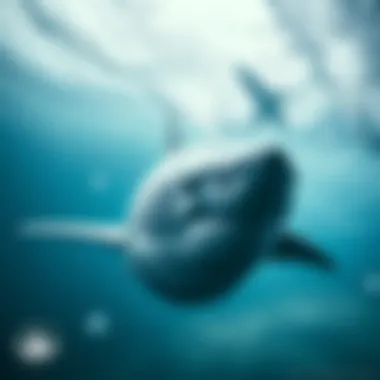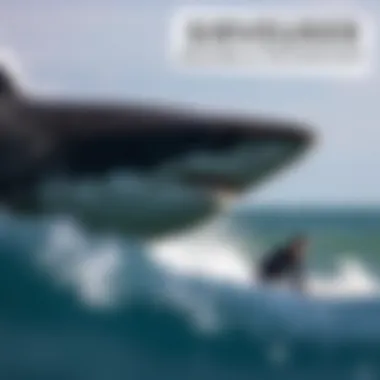Shark Finders: Merging Safety and Technology in Surfing


Intro
Surfing is not just a sport; it's a way of life for many. The roar of waves, the thrill of riding, and the camaraderie among surfers form a unique lifestyle. However, danger lurks beneath the surface, with sharks being a significant concern for those who take to the ocean. In recent years, technological advancements have led to the development of shark finders, which promise to enhance safety while riding the waves. This article will explore the evolution of these systems, their impact on surfing, and how they intertwine with oceanic adventures and environmental considerations.
Shark encounters are not a modern phenomenon; they have been part of coastal narratives for ages. The fear of sharks, however, can sometimes overshadow the joy of surfing. As surfing continues to grow as a popular sport, the importance of safety measures increases. This marks a pivotal point for the surfing community, where advancements in detection technology have the potential to not only mitigate risks but also improve the overall experience for surfers. The aim is not to eliminate the thrill of surfing but to ensure that it is safe enough for enthusiasts to enjoy without undue worry.
As we navigate through this article, we will touch on various aspects of shark finder technology, historical accounts of shark encounters, and the implications for surfers and coastal communities. The balance between enjoying the ocean and ensuring safety is a delicate one, and understanding this dynamic is key to appreciating modern advancements in surfing.
Overall, this exploration provides a thorough understanding of how innovation is shaping surfing experiences while also addressing necessary environmental considerations.
Preface to Shark Finders
The sea can be a wondrous expanse of adventure and freedom, particularly for those drawn to surfing. Yet, it also harbors its uncertainties, especially when it comes to the elusive presence of sharks. Shark finders have surfaced as a pivotal innovation aimed at bridging the gap between the thrill of catching waves and the safety of those who dare to ride them. Understanding this technology becomes vital not only for surfers but also for coastal communities, local governments, and environmentalists alike. Without a doubt, the advent of shark detection systems provides a reassured context for enjoying aquatic pursuits.
Understanding the Need
Every surfer knows that the ocean is unpredictable. The allure of surf culture often overshadows the inherent risks associated with entering the water. Shark encounters, however, add an extra layer of unpredictability. With increasing incidences reported along coastlines, the need for effective shark finders has become all the more urgent. Research indicates that effective shark detection can lead to increased safety during surf sessions and significantly reduce the anxiety surrounding potential encounters.
Moreover, these systems allow surfers to stay informed, thus encouraging more people to engage with their passion for surfing, without the shadow of fear looming overhead. For instance, imagine paddling out into glassy waters, blissfully unaware until a notification on your phone alerts you to a nearby shark sighting. Systems equipped with real-time alerts enable surfers to make informed decisions, whether they decide to continue riding waves or retreat to safety.
Historical Context of Shark Encounters
Historically, shark encounters have been both feared and misunderstood. Accounts stretching back centuries tell stories of fishermen and divers who faced these formidable predators. In the early 20th century, significant shark attacks led to public panic, emphasizing the need for safety measures at popular beaches. This prompted local governments and communities to rethink how they could protect beachgoers.
Although myths and misconceptions about sharks persist, facts speak differently. Studies have shown that sharks rarely pose a threat to humans, and most attacks occur under unusual circumstances. By learning from historical data, modern shark finder systems have evolved to not only detect the presence of sharks but also to educate the public on how to safely coexist with these marine creatures. This critical shift in perspective allows for fostering a more respectful relationship with the ocean's ecosystem.
As we venture further into the technological aspects of shark detection, understanding these underlying motives enhances our grasp of how to navigate the waters with both excitement and caution.
"The ocean stirs the heart, inspires the imagination, and brings eternal joy to the soul." -Wyland
The balance between embracing adventure and ensuring safety is delicate, and shark finders illustrate this intersection vividly. Through this exploration, we gain clarity on what it means to surf responsibly and harmoniously within nature.
The Technology Behind Shark Detection
The landscape of shark detection continues to evolve, driven by technological innovation. As surfers venture into the unpredictable surf, the enhancement of safety measures has become crucial. The importance of understanding the technology behind shark detection lies not only in the level of protection it offers but also in how it integrates into the surfing experience. With advancements in technology, maintaining a balance between the thrill of riding waves and the consciousness of wildlife encounters has never been more manageable. This section explores three pivotal technologies that play an integral role in detecting the presence of sharks in surfing zones: acoustic technology, sonar systems, and drone surveillance.
Acoustic Technology
Acoustic technology is perhaps the backbone of modern shark detection. By emitting sound waves underwater, these systems can detect the unique frequencies of a shark's movements or location. This method comes with significant benefits. Firstly, it allows for the real-time monitoring of marine life, which can inform surfers of nearby shark activity.
The mechanism is straightforward; sound waves travel faster in water than in air, making them an excellent medium for detection. Moreover, the data gathered assists marine biologists in tracking shark migration patterns, which might allow surfsport enthusiasts to choose when and where to catch waves more safely. However, some caveats exist: the accuracy of detection can diminish in busy marine zones or during poor weather conditions. Despite the challenges, the role of acoustic technology cannot be overlooked.
Sonar Systems
Sonar systems represent a more advanced approach in shark detection technology. Unlike basic acoustic tools, sonar uses specific signals and measures the time it takes for sound to bounce back after hitting an object. This pulse-echo technique is widely used in various fields, including navigation and fishing, and is now increasingly applied to ensure surfer safety.


By utilizing sonar technology, surfboards can be outfitted with sensors that alert users when sharks are nearby. This innovation not only amplifies safety but also enhances the surfing experience by removing anxiety about unseen dangers lurking below the surface. Still, the widespread deployment of this technology faces barriers such as cost and the need for ongoing maintenance and calibration.
Drone Surveillance
Drones have taken the world by storm, and their application in shark detection is no exception. Equipped with high-definition cameras and thermal imaging, these unmanned aerial vehicles can monitor vast stretches of coastline. Drones offer a bird's-eye view, identifying shark movements and surf conditions in real-time.
They serve not just for shark detection but also to monitor other elements of the environment — the presence of swimmers, surf conditions, and potential hazards. The data collected can be crucial for local authorities to make informed decisions about beach closures or alerts. Nevertheless, challenges like battery life and transmission range must be addressed for optimal effectiveness.
"In the world of shark detection, technology doesn’t just enhance safety; it transforms the entire surfing experience, offering peace of mind to those who crave adventure on the waves."
Integrating these technologies into everyday surfing practices may require education and adaptation. As awareness grows, it becomes evident that the leap in shark detection methods is shaping the way surfers interact with the ocean. Safer surfing practices, coupled with a deeper understanding of marine life, will likely be paramount as coastal communities navigate their futures in this dynamic environment.
Existing Shark Detection Systems
The concept of shark detection technology has come a long way. Existing shark detection systems serve as crucial tools for safeguarding surfers while they enjoy their time on the waves. Understanding these systems sheds light on how technology has evolved in response to both safety concerns and the realities of our coastal lifestyles. Before plunging into the specifics, it's vital to appreciate the multifaceted role these systems play in the realm of surfing and ocean safety.
Current Technologies in Use
Shark detection technologies have become increasingly sophisticated. Some prevalent systems currently in use include:
- Acoustic Devices: These utilize sound waves to identify underwater movements typical of sharks. When a shark swims into these zones, the system triggers an alert for surfers and lifeguards.
- Drone Surveillance: Unmanned aerial vehicles equipped with cameras monitor beach areas and can spot large sea creatures from above. Drones like the DJI Mavic series offer high-quality imagery, aiding lifeguards in quickly assessing a situation without entering the water.
- Sonar Technology: Sonar systems can effectively scan vast areas of water. The technology sends out sound pulses and measures the return time to detect objects below the surface, even differentiating between various species of marine life.
"Safety over bravado is what keeps surfers surfing. Curated tech saves lives."
These technologies not only improve immediate awareness but also gather data for long-term studies regarding shark behaviors near popular surfing spots.
Comparative Analysis of Systems
When breaking down the shark detection landscape, it’s helpful to compare different systems based on several criteria, such as effectiveness, cost, user-friendliness, and ecological impact.
- Effectiveness: For instance, sonar systems might excel in deep waters, but they could miss stealthy sharks lurking near rocks. In contrast, acoustic devices might have a fine-tuned alert system for more frequent swimmers.
- Cost: Budget-wise, drones can be pricier due to their advanced technology, while simpler acoustic systems may be more feasible for smaller organizations or communities.
- User Experience: Some systems require extensive training to operate effectively. For example, while a lifeguard might easily operate a drone, acoustic systems may need a deeper understanding to interpret the data collected.
- Ecological Implication: Lastly, it is worth questioning how these technologies impact marine life. Systems that emit strong signals might have unintended consequences on shark behavior, pushing them away from popular surf spots in unforeseen ways.
The choice of system ultimately reflects an intricate balance between creating a safer surfing environment and ensuring that marine habitats are preserved. As the surfing community continues to evolve, adaptations of these systems may also reshape the future of ocean recreation.
Impact on Surfing Communities
The evolution of shark finder technology plays a crucial role in shaping the dynamics of surfing communities. As more surfers take to the waves, the safety of these oceanic adventurers becomes more paramount, underscoring the need for effective detection methods. By ensuring greater safety, it allows surfers to enjoy their passion without being weighed down by constant fear and anxiety. Technological advances not only affect safety protocols but also influence community cohesion and response to shark sightings.
Safety Protocols for Surfboarders
In light of the continuous advancements in shark detection technologies, surfboarders are now equipped with well-defined safety protocols that are backed by data and community practices. Don't be fooled, it's not just about wearing bright colors to stand out; it’s about being proactive.
Here are some of the essential safety measures proposed for surfers:
- Awareness of Surroundings: All surfers need to keep an eye on the water. If something feels off, it’s better to be safe than sorry.
- Buddy System: Surfing with a friend isn’t just fun; it’s a lifeline. Having someone to share the waves with ensures immediate assistance if required.
- Technology Usage: More surfers are adopting personal shark deterrents and monitoring devices, which provide alerts on nearby sharks based on feeding patterns and behaviors.
- Siren Alarms: Some beaches are deploying sirens to warn surfers of potential shark sightings. The sounds can cut through waves and surfers' chatter, alerting them to potential danger.


Implementing these protocols not only helps ensure individual safety but also fosters a collective sense of responsibility among surfers in the community.
Community Responses to Shark Sightings
When a shark is spotted near popular surfing locations, the community’s response varies considerably based on perception and the reliability of shark detection systems. Generally speaking, the reactions can be categorized into three main areas:
- Immediate Action: Many communities have well-established emergency protocols when a shark is sighted. For instance, they might temporarily close beaches or deploy lifeguards to monitor movements.
- Social Media Influence: The role of platforms like Reddit and Facebook becomes prominent post-sighting. News spreads rapidly, leading surfers to share their experiences or advise others to stay out of the water. Sometimes, it creates a stir, which can escalate fear, but in other instances, it fosters communal awareness about shark behavior.
- Long-term Strategies: Engaging with oceanic biologists and using findings from shark detection technologies have led some communities to conduct workshops. These workshops aim to educate surfers about shark behavior, demystifying them while promoting cohabitation with these magnificent creatures.
"Sharks are part of our ocean ecosystems. Understanding them is the key to safe and enjoyable surfing."
The responses reflect a larger narrative—the balance between surfers’ enthusiasm for their sport and the intrinsic responsibilities of being in shark-inhabited waters. The more informed they are, the better decisions they can make, thus enriching the surfing experience for individuals and communities alike.
Environmental Considerations
The integration of shark detection technology within the surfing domain raises numerous environmental considerations that deserve attention. Balancing the safety of surfboarders with the well-being of marine ecosystems is a crucial aspect of advancing these technologies. Understanding this balance ensures that while surfers enjoy the waves, marine life remains unthreatened by detection systems.
Impact of Detection Technology on Marine Life
Shark detection technologies, while designed to keep surfers safer, can have unintended consequences for marine life. Some detection methods, notably sonar and acoustic systems, may disrupt the natural behaviors of marine creatures. For instance, sonar's reliance on sound waves can interfere with communication and navigation patterns in dolphins and other species who rely on echolocation.
Moreover, when these systems are deployed in sensitive habitats like coral reefs, they can instigate stress responses in fish and other aquatic organisms. The real challenge lies in finding solutions that allow for effective detection without infringing upon the acoustic privacy of ocean inhabitants. Protecting the serenity of the ocean is essential, particularly in areas where marine species spawn.
"As technology advances, we must remain vigilant against ecological disruptions, ensuring that safety measures do not come at the expense of the delicate balance within marine environments."
Sustainable Practices in Shark Detection
Sustainability in shark detection is not merely a buzzword; it is a necessity. The objective is to implement technologies that effectively monitor shark populations while minimizing environmental footprint. Various strategies can be employed:
- Use of solar-powered technologies: Deploying solar energy in sensor systems reduces battery waste and lowers reliance on non-renewable sources.
- Designing adaptable systems: Technologies that can be moved or adapted based on seasonal migrations of sharks can reduce the concentration of human-made noise in critical habitats.
- Community involvement: Engaging surfers and local communities in monitoring and reporting shark activity promotes a shared responsibility towards both ocean safety and preservation. When communities become stewards of marine environments, awareness rises, leading to more careful interactions with nature.
By embracing these sustainable practices, the surfing community can foster a relationship with the ocean that respects its inhabitants while ensuring the safety of those riding its waves. It’s a balancing act, one that underscores the importance of responsible innovation that serves both human and marine needs.
For further insights on marine conservation efforts, check out The Ocean Conservancy.
For more on sustainable technology, visit NASA's Green Technologies.
Legislation and Shark Safety
Understanding the intersection of legislation and shark safety is crucial in today’s surfing culture. In a world where adventure meets nature's whim, it’s essential to clearly define rules that protect not just surfers but marine life as well. Legislation in this area focuses on the deployment and management of shark detection technologies, ensures public safety, and conveys the responsibility of both users and authorities. By weaving this legislative fabric, we create a safer surfing environment and promote sustainable practices.
Regulations Surrounding Shark Detection Systems
One of the key elements in the legislation is the regulation of shark detection systems. These regulations dictate how technologies like sonar, drones, and acoustic monitoring should be implemented and maintained. Safety standards specify that any device used must meet certain operational effectiveness, ensuring that it accurately identifies potential threats in the water.
- Licensing and Certification: Entities wanting to establish shark detection systems often need to obtain licenses, requiring them to operate under stringent quality guidelines. Compliance shows that they can efficiently identify sharks, reducing the risk of human interactions.
- Data Sharing Requirements: Regulations might also impose requirements for sharing data with local authorities to analyze patterns of shark activity. This fosters a collaborative approach, enabling beaches to leverage timely information, thereby enhancing safety measures.
- Public Transparency: Ensuring transparency in how and where shark deterrent technologies operate helps build trust within beach communities. If surfers know what's in use, they can make informed decisions on where to surf.
These regulations not only help mitigate potential risks but also encourage responsible use of technology. When enforced properly, they can create a sense of security, allowing surfers to ride the waves with more ease.


Government Initiatives for Beach Safety
Governments worldwide are stepping up with initiatives aimed at fostering safer beaches. This is crucial in areas popular among surfers, as government actions often shape local safety cultures. Here are notable government initiatives:
- Awareness Campaigns: Programs that inform beachgoers about predator behavior and safety protocols are being regularly launched. Providing education helps surfers comprehend the realities of shark behavior, creating an informed public.
- Increased Monitoring Efforts: Many coastal jurisdictions are investing in additional monitoring equipment, often funded through local government grants. This not only enhances surveillance but also builds community confidence that safety is a priority.
- Partnerships with Environmental Groups: Government bodies are forming partnerships with NGOs to balance marine conservation with public safety. This synergy ensures that while surfboards glide over the waves, we are simultaneously protecting the ocean's denizens.
By fortifying these legislations and initiatives, authorities aim not only to shield the surfers from potential shark encounters but also to advocate for responsible practices that respect marine ecosystems. The push towards collective responsibility serves as a reminder that safety and enjoyment go hand in hand, ensuring that the ocean remains a space for thrill and harmony.
"Legislation is like a map; without it, we risk straying off course in the vast ocean of nature's unpredictability."
Future of Shark Detection Technology
The future of shark detection technology is not just a matter of improving safety for surfers and beachgoers; it encompasses a significant evolution in how we interact with our ocean environment. As we embrace newer innovations, it's essential to recognize their long-term implications on both marine life and coastal communities. One of the most important aspects of this future is developing tools that not only alert individuals to shark presence but also contribute positively to marine ecosystem health.
Innovations on the Horizon
As we gaze into the crystal ball of shark detection, several promising innovations stand out. Technologies previously exclusive to research settings are gradually making their way into commercial applications. AI-Driven Data Analysis is at the forefront. With the proliferation of underwater cameras and drones, feeding real-time data into intelligent algorithms offers the potential for enhanced predictive capabilities regarding shark movements. This shift won't just make surfing safer; it can also help in understanding shark behaviors better, fostering coexistence.
Moreover, the development of biometric sensors is on the rise. Imagine surfboards equipped with devices that can analyze environmental changes and alert surfers if a shark appears nearby. This not only boosts safety but also transforms surfboards into personal guardians, offering users real-time information.
Another exciting avenue is the integration of mobile applications that can aggregate shark sighting data from multiple sources, including fellow surfers. These apps can provide not just alerts but also historical data on shark behaviors, which may influence surf conditions and surfers’ safety strategies. Facilitating a community-driven approach can create a safer surfing environment by allowing surfers to share information in real-time.
Integration with Surfing Equipment
Incorporating shark detection technology into surfing equipment represents a paradigm shift in how surfers engage with the ocean. Smart wetsuits embedded with sensors can monitor the surrounding waters and send alerts to surfers' mobile devices. Imagine paddling out, feeling the thrill of the waves, while your wetsuit discreetly informs you if there's an elevated risk nearby.
Moreover, surfboards that come equipped with sonar systems could aid surfers in identifying underwater hazards and not just sharks. This multifunctional approach enhances surfers' overall experience, allowing them to focus on what they love—riding the waves—while still prioritizing safety.
Furthermore, collaborative initiatives between tech developers and surf brands underline the commitment to safety. Companies like Rip Curl and Garmin have already started exploring ways to fuse their technologies with in-water devices. Take for instance the partnership between these brands, where they designed surfboards with integrated GPS and communication systems. This evolution not merely represents innovation; it reflects a shift in mindset, where safety and adventure go hand in hand for surfers.
Without a doubt, the future of shark detection technology holds immense promise in reshaping our understanding of the ocean while safeguarding our shared adventures.
As the surfing community embraces these changes, there lies an inherent responsibility to ensure that advancements are made sustainably, protecting the delicate balance of marine ecosystems. Together, the symbiotic relationship between technology and nature can create a safer, more insightful surfing experience for generations to come.
Closure
In the exploration of shark finder technology and its implications on surfing, it’s crucial to recognize the confluence of safety and the allure of adventure. This article has spotlighted the advances made in shark detection systems, shedding light on their critical role in fostering a safer environment for surfers.
Reflecting on Safety and Adventure
Surfers have long danced on the delicate line between the thrill of conquering waves and the inherent risks of the ocean. Shark finders represent a significant leap forward in mitigating those risks. By integrating innovative technologies such as drones, sonar, and acoustic systems, the surfing community has embarked on a journey of enhanced safety without sacrificing the excitement that draws them to the water.
However, while emergency preparedness undoubtedly benefits from these advancements, it is important to approach the ocean with respect and reverence. Surfers must balance their adventurous spirits with the knowledge that technology, although revolutionary, cannot fully eliminate the unpredictable nature of the ocean. Instead, it acts as a support system that provides valuable information about shark movements while surfboarders maintain their vigilance.
There’s an undeniable beauty in riding the waves, a kinship with the aquatic ecosystem that cannot be understated. As communities grow increasingly aware of both safety concerns and environmental impacts, meaningful conversations surface — both in beachside cafes and online forums.
"Safety is not just about technology; it’s about understanding and coexisting with nature."
As the dialogue continues, surfers are encouraged to engage in activism aimed at preserving marine environments. This holistic approach ensures that while technology safeguards their surf experiences, it also nourishes the very waters they love.
Thus, the future of shark detection technology holds promise, not just for securing safety, but also for enhancing the collective surfing culture. By keeping the conversation alive and laying focused efforts on sustainable practices, surfers can enjoy their passion while contributing to the preservation of the oceans. As we witness innovations unfold, it becomes clear that safety and adventure can harmoniously coexist in the ever-evolving landscape of shark finders.















